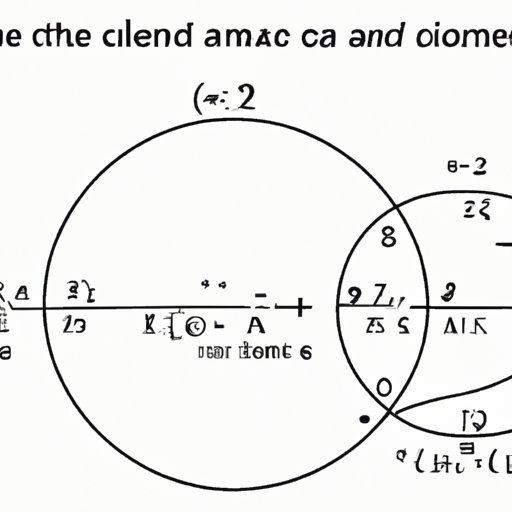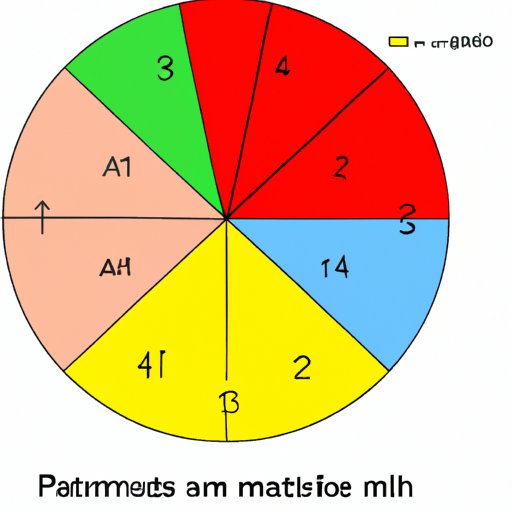I. Introduction
A circle is one of the most fundamental shapes in geometry. It has numerous real-world applications, from calculating the amount of fencing needed to enclose a round garden to designing circular architecture. To fully understand and utilize the properties of a circle, one must know how to find its various measurements, including its area. In this article, we will guide you through the process of calculating the area of a circle by using a simple formula, step-by-step instructions, and visual aids.

II. Understanding the Formula for Finding the Area of a Circle
The formula for finding the area of a circle is A = πr2, where A represents the area, π represents pi (3.14), and r represents the radius of the circle. The radius is the distance from the center of the circle to any point on its edge.
To understand the formula, let’s break down each variable:
- The value of pi is a mathematical constant that represents the ratio of a circle’s circumference to its diameter. Regardless of a circle’s size, pi is always the same number, which is approximately 3.14.
- The radius of a circle is a line segment that runs from its center to its edge. The value of r can be found by measuring the distance from the center to an edge point of the circle.
- Squaring the radius means multiplying it by itself. For example, if the radius is 3 inches, you would square it by multiplying 3 x 3 to get 9.
Now that we know what each variable means, let’s explore how to use the formula through some examples.
Example 1: Find the area of a circle with a radius of 4 feet.
A = πr2 = 3.14 x 4 x 4 = 50.24 square feet.
Example 2: Find the area of a circle with a radius of 7 centimeters.
A = πr2 = 3.14 x 7 x 7 = 153.86 square centimeters.
Example 3: Find the area of a circle with a radius of 12 meters.
A = πr2 = 3.14 x 12 x 12 = 452.16 square meters.
III. Step-by-Step Guide to Calculating the Area of a Circle
Now that we have a better understanding of the formula, let’s walk through the step-by-step process for calculating the area of a circle:
- Measure the radius of the circle.
- Square the radius of the circle by multiplying it by itself.
- Multiply the squared radius by pi (3.14) to get the area of the circle.
- Label the area with the appropriate units, such as square feet or square centimeters.
Example 1: Calculate the area of a circle with a radius of 5 inches.
- Measure the radius of the circle: r = 5 inches.
- Square the radius by multiplying 5 x 5 to get 25.
- Multiply the squared radius by pi (3.14): A = 25 x 3.14 = 78.5 square inches.
- Label the area with the appropriate units: 78.5 square inches.
Example 2: Calculate the area of a circle with a diameter of 12 feet.
- Measure the radius of the circle by dividing the diameter by 2: r = 6 feet.
- Square the radius by multiplying 6 x 6 to get 36.
- Multiply the squared radius by pi (3.14): A = 36 x 3.14 = 113.04 square feet.
- Label the area with the appropriate units: 113.04 square feet.
When calculating the area of more complex shapes or those with curved edges, such as rings or circular frisbees, you will need to break the object down into separate parts. Calculate the areas of the smaller circles and then add them together.
IV. Practical Applications of the Area of a Circle
The area of a circle has practical applications in various fields, making it a crucial concept to know. Some examples of its applications include:
- Determining the amount of paint or flooring material needed for a circular room or deck.
- Measuring the area of a circular garden bed to determine how many plants can fit.
- Calculating the area of a circular field to determine how many crops it can support.
- Designing circular parts for machinery or tools.
- Calculating the volume of a ball by using the area of a circle formula.
These real-world applications highlight the importance of understanding how to find the area of a circle.
V. Visualizing the Area of a Circle: How to Use Diagrams and Images
Visual aids can help you better understand the concept of finding the area of a circle. One visual tool that can be useful is a diagram or image that shows a circle with the radius labeled. Draw a circle and label the radius using a ruler or compass to help visualize the formula.
Another useful visual aid is an animation that demonstrates how the area of a circle changes as the radius lengthens or shortens. These images can help you understand the relationship between the radius and area and how pi comes into play.
VI. Discovering the Relationship between Circles and Pi
We briefly discussed pi earlier in the article, but let’s dive deeper into its relationship with circles. Pi is a mathematical constant that relates the circumference of a circle to its diameter. Regardless of a circle’s size, pi remains the same value.
The relationship between pi and circles is essential for calculating the area of a circle because the formula uses pi. The value of pi is an irrational number, meaning it cannot be written as a simple fraction and instead has an infinitely long decimal. The most commonly used approximation for pi is 3.14, but the value goes beyond that.
Here’s how pi works in the formula for finding the area of a circle:
- Find the radius of the circle and square it to get the radius squared.
- Multiply the radius squared by pi (3.14 or an approximation) to determine the area of the circle.
Example: To find the area of a circle with a radius of 6 inches, we would square the radius (6 x 6 = 36) and then multiply by pi (36 x 3.14 = 113.04).
VII. Common Mistakes to Avoid When Calculating the Area of a Circle
Like any mathematical formula, there are some common mistakes to watch out for when calculating the area of a circle. Some of these include:
- Using the diameter instead of the radius in the formula. Remember, you must measure the radius first and then square it.
- Misreading the value of pi. Make sure you’re using the correct approximation or exact value, depending on the level of precision you need.
- Forgetting to square the radius. It’s an essential step in finding the area of a circle.
- Mistakenly placing the units in the wrong place. Be sure to label the area with the correct units (square inches, square feet, etc.).
To avoid these mistakes, double-check your work before submitting your final answer. It’s always a good idea to use a calculator or computer program to assist you in the calculations to eliminate human error.
VIII. Exploring Alternative Methods for Finding the Area of a Circle
While the standard formula is the most common and straightforward way to calculate the area of a circle, there are a few alternative methods to consider. These include:
- Using the circumference of the circle to find the area. Rather than using the radius, you can use the circumference to find the area by dividing it by 2 and then squaring the result. The formula is A = (C/2)2 x π, where C is the circumference of the circle.
- Using a sector of the circle. A sector is a part of a circle that includes a central angle. By using a sector, you can calculate the area of a circle without using pi.
IX. Conclusion
Knowing how to find the area of a circle is critical in many fields, from architecture to agriculture. By understanding the formula, following a step-by-step guide, and utilizing visual aids, you can master this essential mathematical concept. Remember to watch out for common mistakes and consider alternative methods when necessary. With practice and patience, you’ll be well-equipped to tackle any circle-related calculation with confidence.
